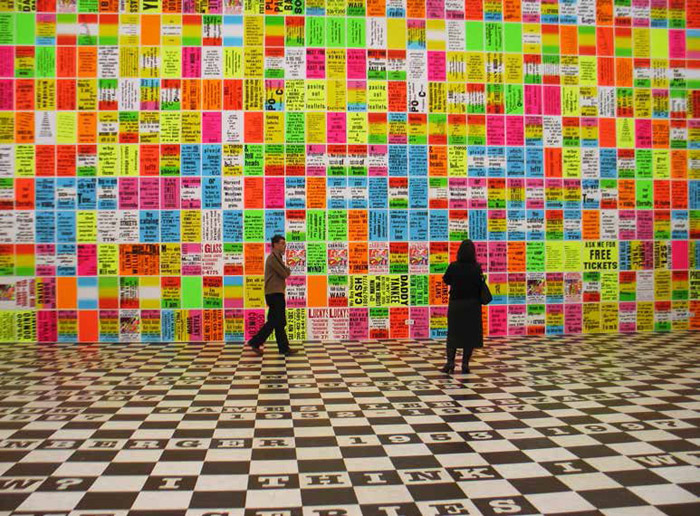We point kaleidoscopes at the light to examine the creation of forms. The Allen Ruppersberg Sourcebook: Reanimating the 20th century, is a similar contrivance. It’s the second sourcebook in a series by Independent Curators International (ICI). The sourcebook is made up of archival materials, which were influential to Allen Ruppersberg’s art, specifically over nine projects (1978-2012).
It begins with several outré clippings—a photograph of Joe Gould and his oleaginous ringlets, one of Allen Ginsberg during the 1957 obscenity trial of Howl, and another of a tree populated by California’s “odd and eccentric folk.” The latter taken from a terrifically disparaging article on Midwest bushwhackers.
Reprinted writings of Nicholson Baker, Sharon Sandusky, Michael Lesy, Marshall McLuhan, Allan Kaprow and Allen Ginsberg follow; these reprints investigate the plight or obliteration of textual or non-textual materials, i.e., film and literature. Each reprint also attempts to analyze the value of rebirth, or repurposing the past as means to sustain a material or intellectual property.
Without question, this sourcebook delivers the importance of a Tigris River running black with ink after a siege; and it allows us to wonder why we slice out the tongues of Philomela and Lavinia. Yet it demands a dialog by carefully showing the anatomy of soil, which came before Ruppersberg’s art. In doing so, it retrieves a mélange of even more provoking images: a mint 1961 report card with a “C” grade, a LIFE magazine cover of a picker perched on a watermelon cart, and an identity photograph of what today may still be of estranged New Orleans jazz musicians.
One of the nine projects, titled Siste Viator (Stop Traveler), is classic Ruppersberg. At the Sonsbeek 93, in Arnhem, Ruppersberg interviewed local librarians to find popular books read by soldiers during WWII. He meticulously reproduced twenty of these titles one hundred times. He reproduced the works in English, Dutch, German, and Polish languages. Then he exhibited them in a workman’s trailer as well as a local bookshop. The project was successfully timeless.
The Singing Posters project is also worth mentioning. This recreated Ginsberg’s poem Howl, in fantastic funk, soul, and jazz style show posters. The posters were neon-bright (undiluted) and were portioned with enough poetry to be read aloud, hopefully in rhythm. The Allen Ruppersberg Sourcebook: Reanimating the 20th century is just as impressive as it is courteous. It gives insight into the artist’s most innovative concepts—a brilliant compendium of what is not forgotten if we collect its message.
By Robert Kravolec
























